
Last Days of Summer On the Miramichi 2024
Fishing Friends –
It seemed like this summer’s heat would just never end, but suddenly we’ve had a little bump in water levels, temperatures have cooled and the cold-water pools are reopened. The next 10 day’s forecast looks pretty good too. I’ll be headed up on September 6th for the rest of the season, and as always, I’m really looking forward to it.
Let’s start out by reviewing the trap numbers through August 15. As we reported earlier the SWM had 122 salmon on July 15, that jumped to 139 on July 30, but only rose to 143 by August 15. The NWM had 44, 58 and 59 for the same dates respectively. The traps have only limited catching efficiency, and these numbers normally represent somewhere between 5 and 7% of the total salmon run to that date. They are definitely down from long term averages, but if we have a decent fall they will be within the norms of recent years. The tiny number of arrivals between July 15 and August 15 could very well be attributed to unrelenting warm, low water that could discourage new fish from entering the system.
I have played around a lot in the past with trying to forecast how many fish may end up arriving in the fall run. It is a close to useless exercise, but it is definitely possible that we will see a much better fall run than we have the last two years. That is because in 2022 and in 2023 we had water much higher and cooler than normal through most of the summer. Fish were being caught way up the Cains in July and August. We certainly haven’t heard of that this year.
Grilse numbers, on the other hand, so far are dismal. It is not unprecedented that we will see a fall bump in those numbers, but I’m not counting on it. It has been a tough year for almost all salmon rivers except those in the far north of the fish’s range, but the relatively poor returns of grilse compared to salmon can be laid right at the feet of the excessive striped bass population.
I talked to a few of the fishing lodges along the Miramichi this morning. Upriver of Boiestown the water temperatures are a lot cooler, and they have been allowed to fish, but they have been relegated to mornings only through a large part of the summer. Rocky Brook and Salmon Brook camps said their catch was down considerably over a normal season, but they do have fish, and some are being caught. Another angler fishing further up at Burnt Hill just said that there were fish around and some were being caught.
Wayne O’Donnell of Rocky Brook said that one piece of good news was that stripers have been hard to find in his stretch of the river this summer. They have only caught three so far all season. Karl Wilson, however, has shown me photos of striped bass caught near his lodge in McNamee by targeting them with sinking lines and larger flies while fishing during low light conditions. Without question there are some number of stripers in residence during the summer more or less throughout the Miramichi, and those bass are eating parr every day.
In the lower river, because of the warm water closure, there have been few anglers on the water. The cold-water pools are holding some number of fish, and Eddie Colford of the Black Brook Salmon Club said that they saw quite a few fish on this first morning back fishing. They caught two nice salmon and rolled several. Other camps are hoping to put anglers on the water during this weekend. While they rolled fish on bombers the fish landed took the venerable green machine!
I’m certainly in hopes that this fall’s fishing will be similar to what I think of fall fishing as being like on the Miramichi. Typical falls would have low but cool water through most of the period. Occasionally, you’d get some rain, and with these bumps in water level a new pulse of fish would enter the river. Even in low water, though, a few fish would be entering the pools daily. This meant that you did not depend on fish moving through the pool to have a target. You had fish holding in the pool that you could work on. You might not always have hot fishing, but there was a feeling of constant opportunity as opposed to the hit or miss created by large raises of water that would suck all the fish upriver and leaving you with little or nothing after they have passed.
Here’s a link to a letter sent recently by the Atlantic Salmon Federation and the Miramichi Salmon Association. Clearly getting such a large increase in quota to 175,000 striped bass is good news, especially if it actually gets caught. Both groups – as well as other involved organizations like the New Brunswick Salmon Council – are to be commended on putting out the effort to move the needle this far with DFO. As alluded to, though, we need to do much more for the Miramichi salmon to recover. The letter says that DFO is holding on to a lower reference point of 330,000 bass. Top scientific experts on the subject, though, claim that the Atlantic salmon in the Miramichi cannot exist with a long-term striped bass population of greater than 100,000 spawners. These same scientists also claim that the 330,000 level has been calculated in error. Alternative methods of calculating the striped bass lower reference put it as low as 50,000 individuals. The lower reference point is supposed to be the point at which going below that may do irreparable harm to the population. When a population that probably hasn’t had over 50,000 spawners in the past 50 years, goes from 3,000 to 500,000 in 15 years, it is inconceivable that 330,000 is a minimum safe population number.
There is very justifiable concern that First Nations will not reach their striped bass quota. I have proposed – and still do – that this fishery should not be limited to FN participants. Before DFO shut down the fishery FN didn’t fish for striped bass commercially. Why should the whole fishery simply be given to one party? Clearly, though, that train has left the station. I am told that FN has been talking to Miramichi Bay gaspereau trap netters about utilizing them to help harvest the bass. That sounds like a great idea to me.
Last, there is nothing in the ASF/MSA letter about stocking. Every prominent, independent biologist that I know believes that the Miramichi system needs a heavy-duty stocking program – SAS or fry, or both – to recover the river’s salmon population. DFO has already agreed to increased stocking, but the extent of that as well as the exact methods to be used and funding arrangements need to be worked on.
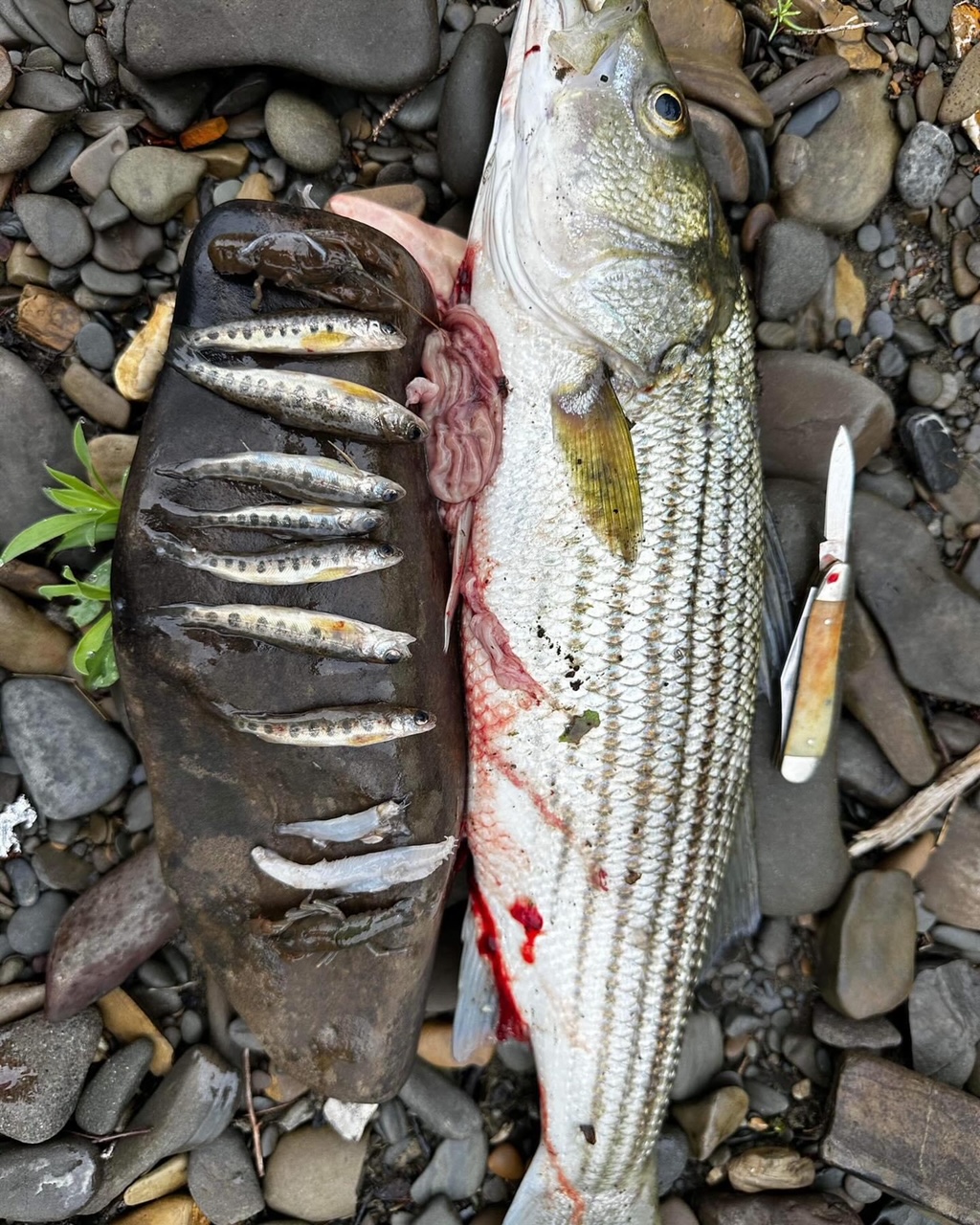 The Miramichi isn’t the only river struggling this year. I’ve heard from a couple of sources who fish frequently up on the Gaspe that the runs to date on both the Bonaventure and the Matapedia are in each case down under 1,000 salmon and grilse. One angler reported that while salmon fishing on the Restigouche and Gaspe Rivers this June and July he caught three striped bass for every salmon. This photo of a striped bass full of salmon parr has been making the rounds. I’m told it was from The Restigouche River.
The Miramichi isn’t the only river struggling this year. I’ve heard from a couple of sources who fish frequently up on the Gaspe that the runs to date on both the Bonaventure and the Matapedia are in each case down under 1,000 salmon and grilse. One angler reported that while salmon fishing on the Restigouche and Gaspe Rivers this June and July he caught three striped bass for every salmon. This photo of a striped bass full of salmon parr has been making the rounds. I’m told it was from The Restigouche River.
The no-netting agreement with the FN band on the Cascapedia River expired, and in protest for not getting it renewed to their satisfaction members of the band decided to net the river. They put a gill net completely across the river and took out an estimated 750 to 1,000 salmon and grilse. The rest of the run so far this year is counted at 1,859 salmon and grilse, so they may have netted about 35% of the run.
To make matters worse for those fishing on the Cascapedia, FN people sometimes fish the salmon pools with spinning rods before the anglers arrive, keeping any fish that they catch.
I know that I am ragging on DFO, but by god they deserve it. Recently I got a little education from John Bagnall, the Fisheries and Licensing Committee chairman of the New Brunswick Salmon Council and president of Wolastoq (Saint John River) Salmon Recovery Inc.
Here is a link to the short, illustrated article that John wrote for me to share with you. I hope that you’ll read it.
As many of us know the Saint John River salmon run has gone from a strong, important salmon run that boasted a commercial and recreational salmon fishery as well as traditional source of salmon for First Nations people to a remnant population hanging on by a thread. Without a doubt a major reason for this is the construction of Mactaquac Dam a short distance above Fredericton. Additionally, there are other dams on both of the river’s main tributaries. Prior to Mactaquac, and even for more than a decade after its construction though, the river continued to have good production.
In a nutshell John feels that by rapidly drawing down the water levels of the Mactaquac headpond during the time of the smolt run in late May that enough current would be created to flush the smolts out of the huge head pond above the dam. This is crucial because there is a critical time by which the smolts must round the southern tip of Nova Scotia on their way to Greenland. This isn’t the only thing that would help. Better downstream passage is needed on the other dams too. I asked John why all this hasn’t been done, and in essence he said because DFO hasn’t required it. DFO is also required to stock 500,000 smolts into the Saint John each year, and they haven’t done that either.
John feels that by doing these things the Saint John could again support a recreational fishery as well as provide First Nations with salmon which would have the additional benefit of not driving them to net the Dungarvon which is their current source for ceremonial fish.
But enough of all this negative talk. I can’t help but vent a bit in the hope of doing some good, but as one of my fishing friends reminds me don’t let it ruin your enjoyment of what we do have. The Miramichi system still provides as good or better a chance at catching an Atlantic salmon as any river south of the 50th parallel, and on the better days as good as north of it too. Even in recent years of heavy summer flowage sucking in our fall run early, we have still had many days of decent fall fishing. This fall is looking like a good bet. Whether Wilson’s on the Miramichi, The Ledges, Cail’s Salmon Pools, Black Brook Salmon Club, Country Haven, Upper Oxbow Outfitters or any of a number of the independent guides or other clubs or outfitters that I have unintentionally neglected to mention, why not schedule some time this fall to get on the river. It’s magic. If you need some help making a connection or to chat about some options just shoot me an e-mail at bigbass@maine.rr.com.
Thanks for reading. Brad Burns
PS Don’t forget to join or renew your membership in the one conservation organization totally focused on the Miramichi. The Miramichi Salmon Association.
Stay on top of the Miramichi salmon report. I post most days and virtually every day I’m in camp. Here is the link.


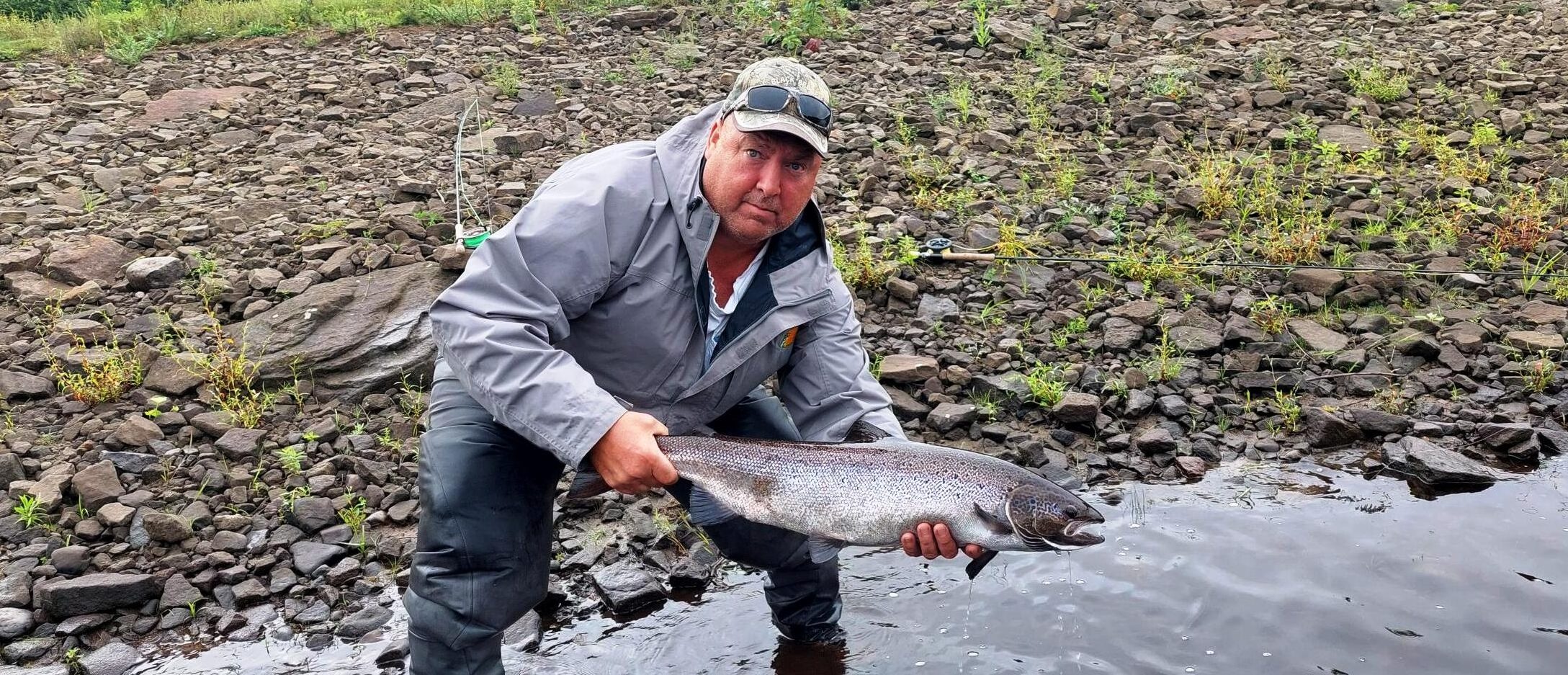
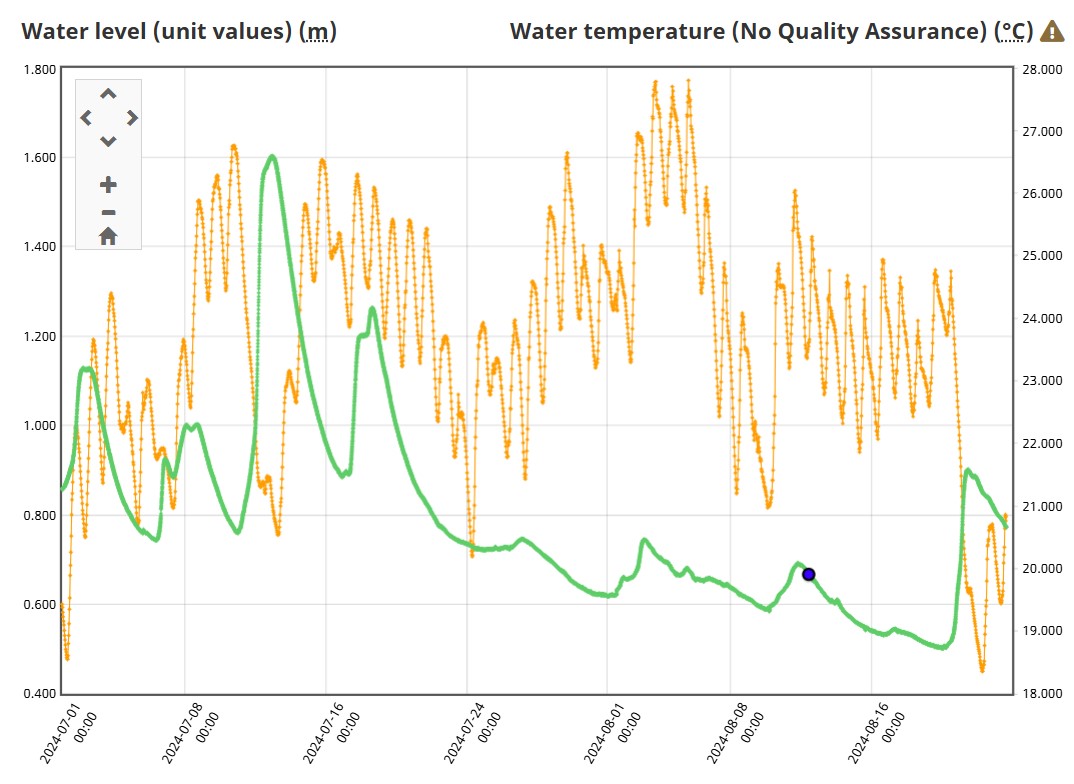
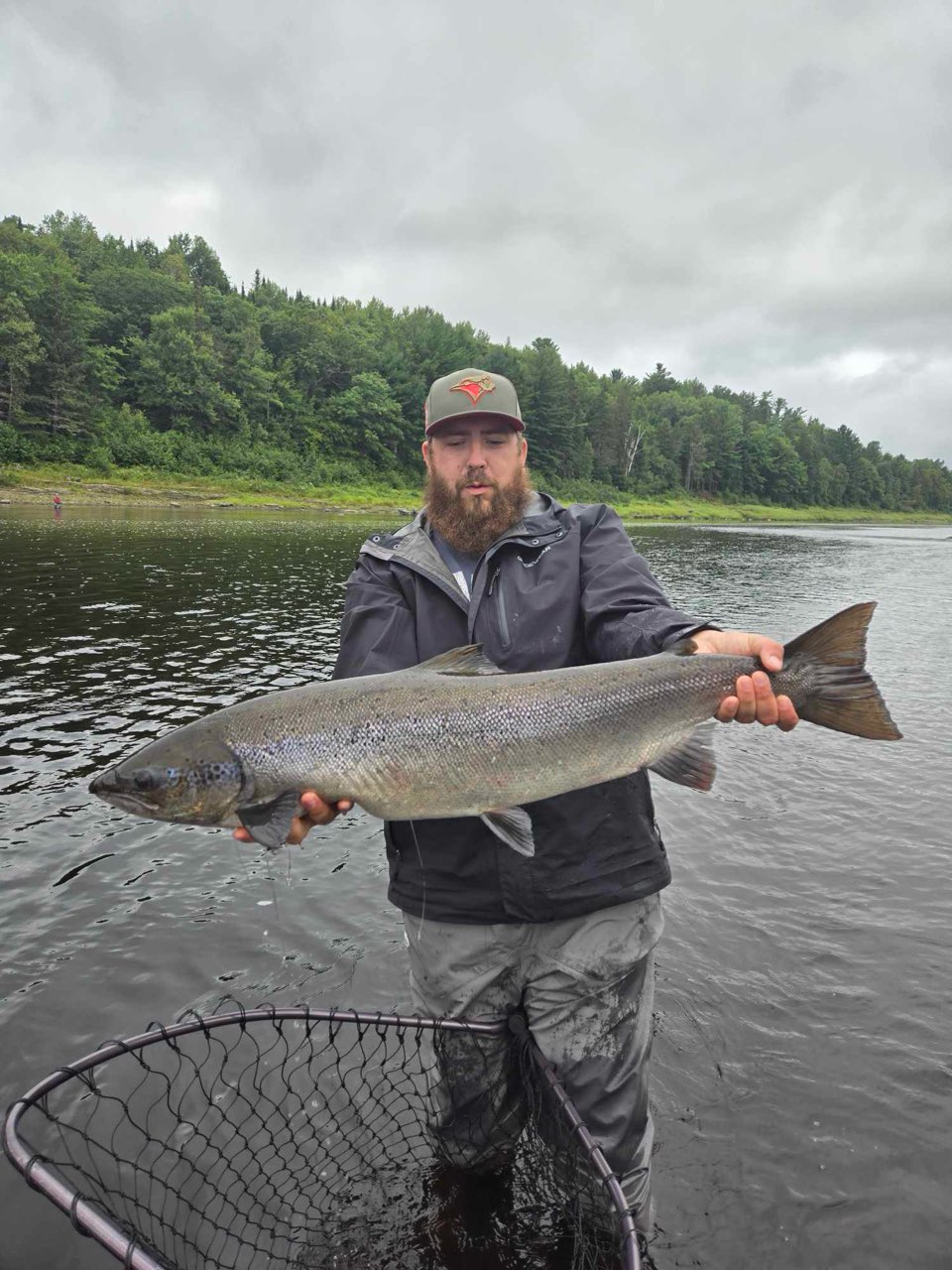
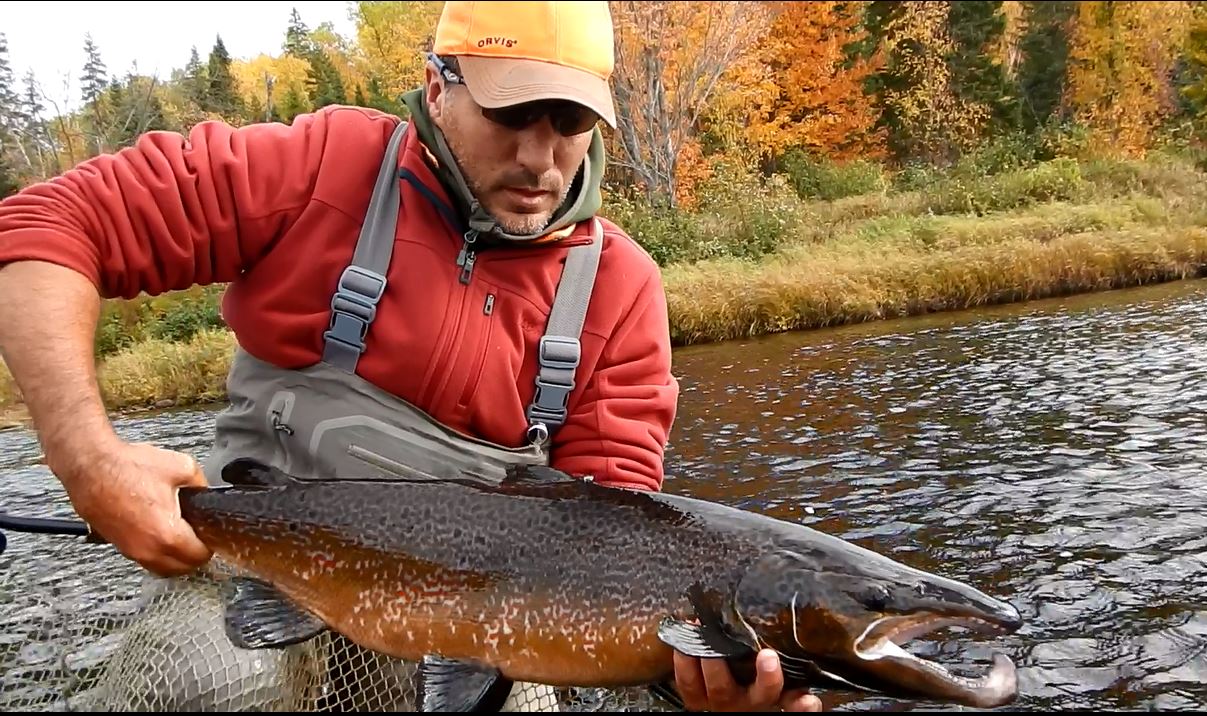
Hey Brad
Thank you for continuing to provide anglers with updated info.
I particularly liked the ‘state of the union’ letter from the MSA and ASF . This type of communication from these hard-working groups should be completed every 5 or 6 months to keep everyone updated.
I know the focus has been (and should continue to be) on reducing the mortality rate of outmigrating smolts via a reduction in striper numbers… but I sure hope we soon begin to hear that the ASF, MSA, ANQUOTUM, and other organizations are pushing g for and getting permission/funding for a substantial increase in stocking… and various types of stocking. The days of thinking our salmon will magically recover to.past numbers on their own are over. Stock ! Stock! Stock
Bob – the thing about the stripers is that unless that population of stripers is reduced – experts say to 100,000 or less – the Atlantic salmon are simply going to disappear completely within a very few years. Even stocking within any volume that we could imagine would not be enough to withstand the current bass numbers.
I’ve talked to several of the top salmon biologists in NB, and they all agree that to bring back the salmon numbers from the current level stocking in serious quantities is going to vital. Brad
Hello Brad,
I’ve just returned from a trip to Northern Scotland, where Mark Adams, his wife Sophie and myself fished the THURSO River for a week. The good news first: Amazingly, fish showed in almost all the pools we fished, the guides rotating their sports, so one gets to fish the various pools during a week of angling. There were fish caught, in fact twelve on the day of our departure, (it figures!), despite low water levels and high water temperatures. Most successful was a group of Scottish fishermen who know the river inside out. Mark, Sophie and I left”skunked”, but cementing our long-time friendship during the course of a week, and that in beautiful surroundings, (one can just detect the coast of the Orkney Islands across the water!) made up for it. We’re aiming to return, though probably not in the month of August, but rather earlier in the season.
Tight lines to all the Miramichi fishermen and to you personally, Brad, when you’re headed up there in September.
John Stucki – Geneva-SWITZERLAND